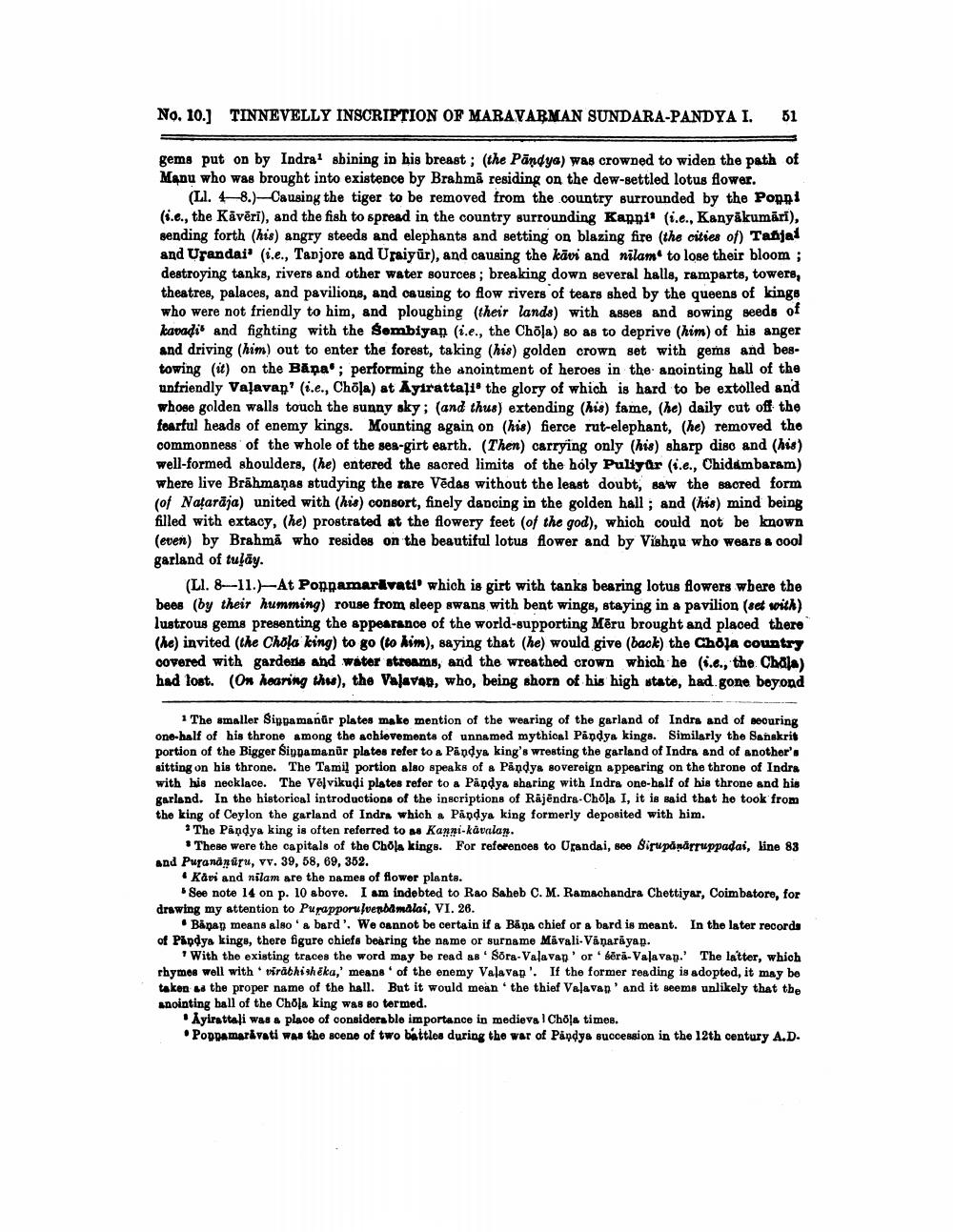________________
No. 10.] TINNEVELLY INSCRIPTION OF MARAVARMAN SUNDARA-PANDYAI.
61
gema put on by Indrat shining in his breast ; (the Pandya) was crowned to widen the path of Manu who was brought into existence by Brahmā residing on the dew-settled lotus flower.
(Ll. 48.)-Causing the tiger to be removed from the country surrounded by the Poppi (s.c., the Kāvērī), and the fish to spread in the country surrounding Kapni: (i.e., Kanyakumāri), sending forth (his) angry steeds and elephants and setting on blazing fire (the cities of) Tanja and Urandai' (i.e., Tanjore and Uraiyūr), and causing the kävi and nilam. to lose their bloom ; destroying tanks, rivers and other water sources ; breaking down several halls, ramparts, towers, theatres, palaces, and pavilions, and causing to flow rivers of tears shed by the queens of kinge who were not friendly to him, and ploughing (their lands) with Asses and sowing seeds of kavadit and fighting with the Sombiyan (i.e., the Chola) so as to deprive (him) of his anger and driving (him) out to enter the forest, taking (his) golden crown set with gems and bestowing (it) on the Bapa; performing the anointment of heroes in the anointing hall of the unfriendly Valavan' (i.e., Chola) at Ayirattali® the glory of which is hard to be extolled and whose golden walls touch the sunny sky; (and thus) extending (his) fame, (he) daily cut off the foarful heads of enemy kings. Mounting again on (his) fierce rut-elephant, (he) removed the commonness of the whole of the sea-girt earth. (Then) carrying only (his) sharp digo and (his) well-formed shoulders, (he) entered the sacred limits of the holy Puliyur (i.e., Chidambaram) where live Brāhmaṇas studying the rare Vēdas without the least doubt, saw the sacred form (of Natarāja) united with (his) consort, finely dancing in the golden hall; and (his) mind being filled with extacy, (he) prostrated at the flowery feet (of the god), which could not be known (even) by Brahmă who resides on the beautiful lotus flower and by Vishnu who wears & cool garland of tulay.
(LI. 8-11.)--At Poppamarivati' which is girt with tanks bearing lotus flowers where the bees (by their humming) rouse from sleep swans with bent winge, staying in a pavilion (set with) lustrous gems presenting the appearance of the world-supporting Mēru brought and placed there (he) invited (the Chola king) to go (to him), saying that (he) would give (back) the Chola country covered with gardens and water streams, and the wreathed crown which he (.c., the Chala) had lost. (On hearing thos), the Valavan, who, being shorn of his high state, had gone beyond
1 The smaller Sippamanür plates make mention of the wearing of the garland of Indra and of securing one-half of his throne among the achievements of unnamed mythical Pandya kinge. Similarly the Sanskrit portion of the Bigger Sippa manür plates refer to a Pandya king's wresting the garland of Indra and of another's sitting on his throne. The Tamil portion also speaks of a Pandya sovereign appearing on the throne of Indra with his necklace. The Vē vikudi plates refer to a Paņdya sharing with Indra one-half of his throne and his garland. In the historical introductions of the inscriptions of Rajendra-Chola I, it is said that he took from the king of Ceylon the garland of Indra which a Pandya king formerly deposited with him.
* The Pandya king is often referred to as Kanni-kavalan.
* These were the capitals of the Chola kings. For reforences to Urandai, see Sirupánårruppadai, line 83 and Puranānūru, vv. 39, 58, 69, 352.
. Kävi and nilam are the names of flower plante.
See note 14 on p. 10 above. I am indebted to Rao Saheb C. M. Ramachandra Chettiyar, Coimbatore, for drawing my attention to Purapporulvenbamalai, VI. 26.
Banan means also a bard'. We cannot be certain if a Bana chief or a bard is meant. In the later records of Pandya kings, there figure chiefs bearing the name or surname Mavali-Vanarayap.
* With the existing traces the word may be read as Sora-Valavan' or 'Sira-Valavap. The latter, which rhymes well with virabhisheka,' means of the enemy Valavap'. If the former reading is adopted, it may be taken & the proper name of the hall. But it would mean the thief Valavan and it seems unlikely that the Anointing ball of the Chola king was so tormed.
• Ayirattali was a place of considerable importance in medieval Chola times.
Poppemarivati was the scene of two battles during the war of Pandya succession in the 12th century A.D.




